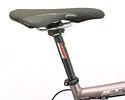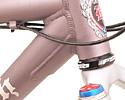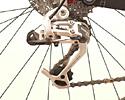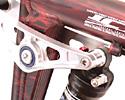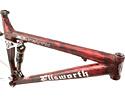
Recently on Cyclingnews.com |
On Test: Ellsworth Truth, August 23, 2006
If this is theTruth, what does that make everything else?
James Huang spends some quality time aboard Ellsworth's premier cross-country suspension mountain bike.
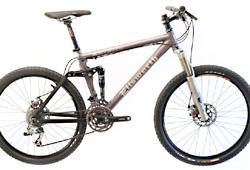
|
Mountain bike rear suspension has evolved in leaps and bounds over the past dozen or so years. Plenty of mistakes were made early on and some designs bordered on comical. However, a handful of those early themes, plus some new ones, have managed to survive the evolutionary cull including the ubiquitous four-bar linkage. True four-bar linkages are just about everywhere these days, but a common misconception is that they all work about the same. Pivot placement is critical in determining not only how the suspension reacts to trail features but also how it reacts to other input. In an ideal world, the rear end is always free to react to bumps and is completely immune to pedaling or braking forces but few designs manage to achieve this goal.
Like so many others, the Ellsworth Truth uses the ubiquitous four-bar linkage design but with a unique twist called Instant Center Tracking. This precise manipulation of pivot points is specifically designed to almost completely eliminate pedaling- and braking-induced suspension movement while retaining excellent bump compliance in all conditions. These are rather heady claims for sure as they represent the ideal case, but after a healthy dose of test time on a Truth, I suspect Tony Ellsworth really may really be on to something here.
Anatomy of the Truth
The Truth is designated as Ellsworth's premier cross-country/endurance racing frame with four inches of rear wheel travel. This is a true four-bar linkage design complete with the critical Horst Link pivots just ahead of the rear dropouts. All of the pivots rotate on sealed cartridge bearings and movement out back are controlled by either a custom-tuned Fox Float R or Manitou Swinger 3-Way Air shock. Note that neither of these shock options is equipped with a manual lockout, nor is there another option for one that is so equipped (we'll revisit this subject later).
Overall frame construction is pretty straightforward: internally and externally butted aluminum tubes are cleanly welded in a near double-diamond configuration to a variety of intricately CNC-machined bulkheads and fittings. In addition to the butting, rear end tube shapes are carefully chosen to optimize structural performance. After welding, frame subassemblies are bead-blasted for improved fatigue strength. Nice little details can be found all over, from the custom CNC-machined aluminum hardware, laser-etched graphics, and rear derailleur cable routing that runs internally through the seatstay for protection from the elements. Frame weights hover right around 5.6 lbs for an 18" frame with shock.
Our 18in test bike came equipped with a mix-and-match kit of Shimano, SRAM, Avid, Mavic, FSA, and Fi'zi:k components. A Fox Float 100 RL handled the suspension work up front. This particular demo bike had clearly made the rounds and the componentry was pretty well-used. Realistically, though, but it was still a solid piece of kit that worked well enough and, most importantly, did nothing to distract from the primary goal of evaluating the suspension performance. Total bike weight as equipped was about 25.8lbs/11.7kg without pedals.
What makes the Truth special
While other frame designs rely on complex valving solutions in order to neutralize suspension geometry issues, Ellsworth has gone about it with an almost completely mechanical approach. Unlike other four-bar linkages, Ellsworth's Instant Center Tracking aligns the chain torque line with the instant center of rotation of the rear end throughout the range of suspension travel. This shortens the moment arm of the chain force about the instant center to just about zero, thus minimizing the effects of pedaling on suspension movement. Um, right… say again? Think of it this way: take a piece of string and a swinging door. The string is your chain force and the door is the suspension moving up and down. If you tie the string to the doorknob, the string has a lot of influence on the movement of the door, and vice versa. Now if the string is tied to the hinge, however, you can pull as hard as you want but you still can't influence how the door swings around. This is an oversimplification, of course, but you start to get the idea.
Since Ellsworth manages to solve the pedal bob and brake jack issues by almost completely mechanical means, the rear shock subsequently does not require much of a platform. However, it's still a good idea to have a little bit to resist weight shifts and whatnot. As such, the Fox shock is custom-tuned for Ellsworth and utilizes a minimal level of Propedal platform valving with externally adjustable rebound damping. The Manitou Swinger 3-Way Air is not custom-tuned out of the box, but it does add a user-adjustable platform. Both shock options were tested here.
Go, go, go!
Out on the trail (or road), the first thing I noticed was the fantastic pedaling response. Under power, there was virtually zero pedal bob even when using an intentionally poor pedal stroke. I will almost go so far to say that it was nearly as good as any hardtail I've ridden. Go ahead and mash the pedals or stand for a sprint and nothing inappropriate happens back there, even when running an artificially high or low shock pressure. Additionally, the suspension remained similarly immune in a variety of gear combinations, which was a pleasant surprise since the chain torque line changes with different gear ratios. In theory, this makes it impossible to keep the chain torque line aligned with the instant center of rotation all the time as you run through the gears but apparently things remain aligned closely enough that it doesn't matter much. Perhaps it matters on paper, but none of us ride on paper, now do we?
I was also somewhat surprised to discover that the rear shock options have rather different personalities. Overall, the Fox rear shock performed well enough with an appropriately progressive spring rate and good motion control. However, what little Propedal valving remained after the custom tune still produced some very slight, but perceptible, initial impact harshness that I was never able to completely tune out regardless of shock settings. This initial spike was most noticeable on square-edged hits and stutter bumps. I wouldn't go so far to say that the overall ride quality was "harsh", but the initial shock hesitation was somewhat distracting. The rear end never felt as planted as I would have liked and there was just too much buzz coming up through the rear for my taste. Keep in mind that I am barely 160lbs fully loaded so a heavier rider would likely not have the same experience.
When equipped with Manitou Swinger 3-Way Air, the Truth was a different animal, and a rather fantastic one at that. Unlike the Float which has a non-adjustable pedaling platform, the Manitou's platform valving is externally adjustable by varying air pressure in the SPV chamber. When set with the minimum allowable platform pressure, any hint of initial impact harshness was completely eliminated and both big, square-edged bumps as well as stutter bumps were swallowed up with aplomb. Additionally, the outstanding pedaling response remained along with a near-perfect amount of trail feel and braking did little, if anything, to affect the suspension performance in a variety of situations. My initial experiences with the Fox shock fell a hair short of my expectations of this frame, but the suspension performance with the Swinger 3-Way far exceeded them.
Once the rear shock issues were ironed out, I was able to pay more attention to the rest of the bike. In spite of its complexity, the rear end has an admirable level of lateral and torsional rigidity and all of the pivot hardware remained tight throughout the test. Under braking, the rear end remained active and brake jack (suspension stiffening and extension under braking) was minimal. Handling was pleasantly neutral with the now de rigueur longish top tube plus shortish stem offering stable handling at speed and on descents while still retaining good maneuverability in tight singletrack.
Conclusions
Overall, there are only a handful of things I could ask of the folks at Ellsworth. Mud clearance in the frame was adequate both up top and down below, but the box-section chainstay yoke provides a neat little shelf for mud tossed up by the rear tire. Secondly, the frame is disc-compatible but there were no proper provisions for securing the hydraulic line on the rear triangle.
All in all, the Swinger-equipped Truth is exactly how I would want a fully suspended bike to perform. The ride was perfectly controlled with excellent bump absorption and trail feel with snappy response and claw-like climbing traction. Given that the Ellsworth Truth has been one of the most successful bikes on the endurance-racing circuit for non-sponsored riders, I'm apparently not the only one who feels that way.
Changes for '06
Our '05 test bike was no slouch as it was, but Ellsworth went back to the drawing board for the '06 model year with a redesigned Truth. The rear end geometry remains the same (thankfully), but the rest of the frame has received major revisions, including a completely new front end and rear triangle.
The new front end features more dramatically shaped and butted tubing along with a trick-looking CNC machined upper rocker pivot mount. The top tube is dropped for extra standover clearance, and the seat tube is now reinforced with an additional gusset.
The rear end sees the biggest change in the chainstay assembly (the seatstay assembly appears unchanged from '05). The new chainstays are asymmetric for increased lateral rigidity and decreased weight with a new welded yoke assembly that replaces the massive CNC unit from last year. Sadly, the new frame still lacks a dedicated disc hose mount on the rear triangle.
Lastly, it's hard not to notice the wild new anodized and laser-etched finish. Solid colors are still available, but the new 80s-esque splatter job is oddly attractive. Frame weight for a medium size is 5.6lbs/2.6kg complete with Fox Float R rear shock and seat collar.
Weight: 5.6lbs (18in frame)
Price: US$1,995 (frame only - complete bikes from US$3,747 from our friends
at Competitive
Cyclist.)
Pro: Outstanding pedaling efficiency couple with superb bump absorption
and trail feel
Con: Rear chainstay yoke is a haven for mud, standard Propedal-equipped
Fox Float rear shock unnecessarily sacrifices a bit of small bump compliance
Cyclingnews Rating: ![]()
More information: www.ellsworthbikes.com


